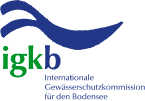SeeWandel: Life in Lake Constance –
the past, present and future
Lake Constance is one of the largest Alpine lakes, on the border between Germany, Austria and Switzerland – an important drinking water reservoir and ecosystem, significant for tourism, recreation, fishing, nature conservation and the use of thermal energy.
In the past century, Lake Constance has undergone extensive changes: untreated sewage and intensive agriculture led to severe lake pollution in the 1950-1980s, and Lake Constance became nutrient-rich (eutrophication). Although the natural trophic state has been almost completely restored thanks to countermeasures that were taken
(re-oligotrophication), there are irreversible changes to the communities of aquatic organisms.
One species of whitefish (Coregonus gutturosus, the Lake Constance whitefish) went extinct during the eutrophication phase, and climate change and the invasion of non-native plant and animal species are potentially endangering natural biodiversity. This can lead to changes in the food webs and affect ecosystem functioning in Lake Constance. Catch yields of fisheries are declining. Due to the spread of non-native mussel species (e.g. Quagga mussel Dreissena rostriformis bugensis), concerns are being raised regarding increased maintenance costs for municipal water suppliers.
Today, there are more than 37 non-native species in Lake Constance, including for example the three-spined stickleback (Gasterosteus aculeatus), the Zebra mussel (Dreissena polymorpha), the killer shrimp (Dikerogammarus villosus) and the aquatic flea species Daphnia galeata.
The project SeeWandel investigates the effects and significance of nutrient decline, climate change, non-native species and other stress factors for the Lake Constance ecosystem, its biodiversity and functioning, as well as the utilisation of lake resources by people. SeeWandel comprises 13 sub-projects that address these current problems using a wide variety of research methods, whilst considering the Lake Constance ecosystem as a whole. Comparative studies in other lakes (e.g. Lake Walen, Lake Zurich) make it possible – for some areas of research – to generalise knowledge and conclusions drawn from Lake Constance, and to place the processes observed in Lake Constance in a wider context.
SeeWandel officially started in January 2018 with a duration of 4 years and 6 months (until the end of June 2022).
The impairments in SeeWandel caused by COVID-19 will be compensated by additional financial resources (project “SeeWandel-Covid”) and an extended project duration (until the end of June 2023). One of the central goals of SeeWandel-Covid is to intensify the integration and processing of research results and the target group-oriented knowledge transfer. SeeWandel-Covid receives support from Interreg and the International Commission of Lake Constance Water Conservation (IGKB).
SeeWandel aims to continuously engage with stakeholders, agencies and local authorities as well as organisations to incorporate the diversity of views, needs and goals in the successful development of the project.
The pelagic zone, open water zone, is the off shore area of open water in lakes – habitat for…
… plankton: drifting or floating small organisms that are unable to swim against the current, such as bacteria, algae, branchiopods, copepods, larvae of Zebra mussels
… nekton: actively swimming organisms, such as fish
… neuston: organisms in the surface of the water that rely on the existence of surface tension, such as some algae, bacteria and fungi
… pleuston: organisms living or floating in the surface layer of the air-water interface, such as duckweed, some water ferns
Sub-projects:
Complementary:
Chemical and biological monitoring performed by IGKB.
The littoral zone is the near shore area of lakes, where sunlight penetrates all the way to the sediment. The littoral is characterised by a high photosynthetic activity and is habitat for a species-rich fauna and flora. The littoral zone can be subdivided as follows:
1) supralittoral zone (splash or spray zone),
2) eulittoral zone (zone in the range of water level fluctuations) and
3) sublittoral zone (permanently covered with water).
Depending on the vegetation, further zonations are defined:
a) reed belt,
b) floating-leaf plant zone,
c) belt of submerged aquatic plants and
d) underwater meadows (mostly in nutrient-poor lakes).
Sub-projects:
Complementary:
Chemical and biological monitoring performed by IGKB.
Interested in further information? More details are available here.





